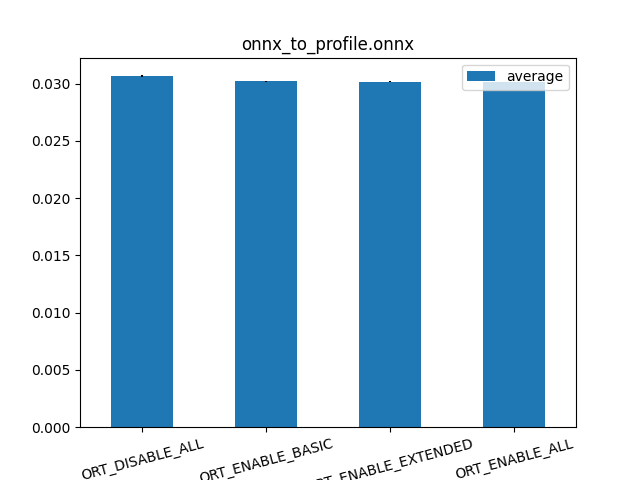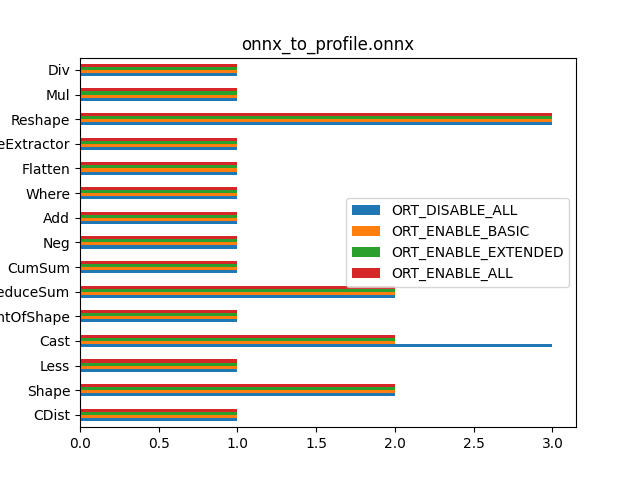Note
Click here to download the full example code
Benchmark onnxruntime optimization¶
onnxruntime does optimize the ONNX graph before running the inference. It tries for example to fuse a matrix multiplication following or followed by a transpose, choosing the most efficient path.
One ONNX file¶
This section creates an ONNX graph if there is not one.
import os
from collections import OrderedDict, Counter
import numpy
import onnx
from cpyquickhelper.numbers.speed_measure import measure_time
import pandas
from onnxruntime import InferenceSession, SessionOptions, get_device
from onnxruntime.capi._pybind_state import ( # pylint: disable=E0611
SessionIOBinding, OrtDevice as C_OrtDevice, OrtValue as C_OrtValue,
GraphOptimizationLevel)
from sklearn.neighbors import RadiusNeighborsRegressor
from skl2onnx import to_onnx
from tqdm import tqdm
from mlprodict.testing.experimental_c_impl.experimental_c import code_optimisation
Available optimisation on this machine.
print(code_optimisation())
Out:
AVX-omp=8
Building the model¶
filename = "onnx_to_profile.onnx"
if not os.path.exists(filename):
print("Generate a graph for %r." % filename)
X = numpy.random.randn(1000, 10).astype(numpy.float64)
y = X.sum(axis=1).reshape((-1, 1))
model = RadiusNeighborsRegressor()
model.fit(X, y)
onx = to_onnx(model, X, options={'optim': 'cdist'})
with open(filename, "wb") as f:
f.write(onx.SerializeToString())
Functions¶
We need to generate random inputs to test the graph.
def random_input(typ, shape, batch):
if typ == 'tensor(double)':
dtype = numpy.float64
elif typ == 'tensor(float)':
dtype = numpy.float32
else:
raise NotImplementedError(
"Unable to guess dtype from %r." % typ)
if len(shape) <= 1:
new_shape = shape
elif shape[0] is None:
new_shape = tuple([batch] + list(shape[1:]))
else:
new_shape = shape
return numpy.random.randn(*new_shape).astype(dtype)
def random_feed(sess, batch=10):
"""
Creates a dictionary of random inputs.
:param batch: dimension to use as batch dimension if unknown
:return: dictionary
"""
inputs = sess.get_inputs()
res = OrderedDict()
for inp in inputs:
name = inp.name
typ = inp.type
shape = inp.shape
res[name] = random_input(typ, shape, batch)
return res
A function which calls the API for any device.
def run_with_iobinding(sess, bind, ort_device, feed_ort_value, outputs):
for name, (value, dtype) in feed_ort_value.items():
bind.bind_input(name, ort_device, dtype, value.shape(),
value.data_ptr())
for out in outputs:
bind.bind_output(out, ort_device)
sess._sess.run_with_iobinding(bind, None)
ortvalues = bind.get_outputs()
return [o.numpy() for o in ortvalues]
Benchmark¶
Let’s choose the device available on this machine. batch dimension is set to 10.
batch = 200
if get_device().upper() == 'GPU':
ort_device = C_OrtDevice(
C_OrtDevice.cuda(), C_OrtDevice.default_memory(), 0)
provider = 'CUDAExecutionProvider'
else:
ort_device = C_OrtDevice(
C_OrtDevice.cpu(), C_OrtDevice.default_memory(), 0)
provider = 'CPUExecutionProvider'
print("provider = %r" % provider)
Out:
provider = 'CPUExecutionProvider'
We load the graph.
with open(filename, 'rb') as f:
onx = onnx.load(f)
Create of the session.
data = []
files = []
legend = []
for graph_opt, name_opt in tqdm([
(GraphOptimizationLevel.ORT_DISABLE_ALL, "ORT_DISABLE_ALL"),
(GraphOptimizationLevel.ORT_ENABLE_BASIC, "ORT_ENABLE_BASIC"),
(GraphOptimizationLevel.ORT_ENABLE_EXTENDED, "ORT_ENABLE_EXTENDED"),
(GraphOptimizationLevel.ORT_ENABLE_ALL, "ORT_ENABLE_ALL")]):
so = SessionOptions()
so.graph_optimization_level = graph_opt
so.optimized_model_filepath = (
os.path.split(filename)[-1] + ".optimized.%s.onnx" % name_opt)
files.append(so.optimized_model_filepath)
legend.append(name_opt)
sess = InferenceSession(onx.SerializeToString(), so,
providers=[provider])
bind = SessionIOBinding(sess._sess)
#####################################
# Creates random data
feed = random_feed(sess, batch)
#####################################
# moving the data on CPU or GPU
feed_ort_value = OrderedDict(
(name, (C_OrtValue.ortvalue_from_numpy(v, ort_device), v.dtype))
for name, v in feed.items())
outputs = [o.name for o in sess.get_outputs()]
#######################################
# The profiling.
obs = measure_time(
lambda: run_with_iobinding(
sess, bind, ort_device, feed_ort_value, outputs),
context=dict(run_with_iobinding=run_with_iobinding,
feed_ort_value=feed_ort_value, outputs=outputs,
sess=sess, bind=bind, ort_device=ort_device),
repeat=10, number=10, div_by_number=True)
obs['name'] = name_opt
data.append(obs)
df = pandas.DataFrame(data)
df
Out:
0%| | 0/4 [00:00<?, ?it/s]
25%|##5 | 1/4 [00:03<00:09, 3.08s/it]
50%|##### | 2/4 [00:06<00:06, 3.05s/it]
75%|#######5 | 3/4 [00:09<00:03, 3.04s/it]
100%|##########| 4/4 [00:12<00:00, 3.04s/it]
100%|##########| 4/4 [00:12<00:00, 3.04s/it]
Graph¶
df = df.set_index('name')
dev = df[['deviation']].copy()
dev.columns = ['average']
ax = df[['average']].plot.bar(yerr=dev)
ax.set_title(os.path.split(filename)[-1])
ax.tick_params(axis='x', labelrotation=15)

The result are similar because the optimized model was very similar.
data = []
for name in files:
with open(name, "rb") as f:
onx = onnx.load(f)
op_names = [op.op_type for op in onx.graph.node]
data.append(Counter(op_names))
df = pandas.DataFrame(data).T
df.columns = legend
df
Graph.
ax = df.plot.barh(yerr=dev)
ax.set_title(os.path.split(filename)[-1])
# import matplotlib.pyplot as plt
# plt.show()

Out:
Text(0.5, 1.0, 'onnx_to_profile.onnx')
Total running time of the script: ( 0 minutes 13.603 seconds)